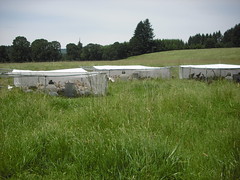
There has been alot of interest lately in using No-soy feed for raising chickens. This is a response to the over-use of soy in animal feed and other food products, possible hormonal effects of soy, concerns over the use of genetically modified soy seed, and difficulties in sourcing local soy (e.g. much of the organic soy used in the Pacific Northwest is sourced from China).
During the summer of 2009, utilizing the efforts of an enthusiastic intern, we conducted an informal trial to compare Soy vs. No-soy feed utilization among Cornish X (straight-run), Delaware (males), and Rhode Island Red (males). The No-soy feed was sourced from Union Point Feed using a 21% ration with peas as the primary protein source. We used a crumble (pelleted feed that has been mashed up a bit) so the birds could consume the entire ration (this formulation was derived based on the experiences of some growers reporting negative selection on the peas). The Soy-based feed was also sourced from Union Point Feed using their standard broiler mix.
All birds were raised on pasture in 10' x 10' mobile pens. Birds were weighed weekly and feed consumption was tallied weekly as well. At the end of the study we calculated feed conversion based on live weight and on finished weight (dressed bird).
Results Table
Not surprisingly, the Cornish X birds had the best feed conversion ration (lbs of feed per lb of gain) of all breeds. In addition, the Soy-fed Cornish X gained better than the Non-soy Cornish X, but only marginally. While the feed conversion ratios were greater (using more feed to gain weight) and time to finish was longer for the Delawares and Rhode Island Reds, it is interesting that these breeds actually had better feed conversion ratios on the No-soy feed.
Another interesting point in this particular study is that there was a far higher mortality in the Cornish X Soy-fed pen. Thus, while the feed conversion was optimized, our actual calculated profit on this batch was lower than the No-Soy pen due to the higher mortality. While this is not statistically significant, it would be worth looking at possible health effects of various feeds in pasture-based chicken trials.
We also had some issues with the Delaware pens, in that the birds developed a nasty habit of pecking each other. This was our first time raising Delawares and we don't know if this is common for the breed or not, when using males only in a pasture-based situation. The problem seemed to get worse the older the birds got.
It would be worthwhile to do additional work comparing more favorable pasture-based broilers in this type of study, icluding: Freedom Rangers (aka Red or Black Rangers), or La Belle Rouge. These birds finish slightly longer than Cornish X (9-11 weeks versus 8 for Cornish X) but do not take nearly as long as the Rhode Island Reds or Delawares (14-16 weeks).
